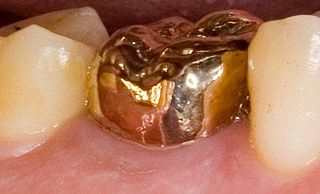Loading AI tools
Form of dental prosthesis From Wikipedia, the free encyclopedia
Gold teeth are a form of dental prosthesis where the visible part of a tooth is replaced or capped with a prosthetic molded from gold.[1]
This article has multiple issues. Please help improve it or discuss these issues on the talk page. (Learn how and when to remove these messages)
|

The first printed book on dentistry, Artzney Buchlein (or The Little Pharmacopaeia), was published by Michael Blum in 1530 in Leipzig. The book provides advice on treating tooth decay, recommending cleaning the cavity and filling it with gold leaf. This advice is attributed to Mesue, though his identity is uncertain. The use of gold leaf for dental fillings was confirmed by earlier Renaissance figures like Giovanni d'Arcoli and Giovanni da Vigo.[2]
Gold dental appliances have gone in and out of popularity as a status symbol for many years. Archeologists also found gold dental appliances from the Etruscan people of Italy, as early as 630 BCE, interpreting them to be some of the earliest forms of bridges and replacement teeth. Gold wire was used in dentistry in ancient times,[3] and for filling cavities in the 19th century.[4] Gold is suitable for dentistry because it is malleable, nearly immune to corrosion, and closely mimics the hardness of natural teeth, thereby causing no harm to natural teeth during chewing.[5] Gold was used before silver became available and has continued to be used for specialized purposes.[5] Dental restorations are often made from a combination of precious metals.[5]
As the dental industry adopted CAD/CAM processes for most of the crown and bridge fabrication, gold manufacturing still relied on the ancient "lost wax" technique, which requires a significant amount of time, skill, and labor. Recent developments have seen the advent of CAD/CAM milling of 100 mm diameter pucks of dental alloy to facilitate the direct milling of crowns and bridges from the solid puck. This effectively eliminated the risk and difficulty of the lost wax process and simultaneously improved upon the quality of the devices.[6]

In Auschwitz: A Doctor's Eyewitness Account, concentration camp survivor Dr. Miklós Nyiszli (who served on Dr. Josef Mengele's medical kommando) describes the "tooth-pulling kommando". These teams of eight, all "fine stomatologists and dental surgeons" equipped "in one hand with a lever, and in the other a pair of pliers for extracting teeth", worked in the crematoria. Stationed in front of the ovens, their job was to pry open the mouths of prisoners who had been gassed and extract, or break off, "all gold teeth, as well as any gold bridgework and fillings". The teeth were collected and stored at the camp before being sent on to the Reichsbank to be melted down and converted into gold bullion, which could then be sold with no trace of its origin.[7]
Gold alloys are still used by dentists today. They most often combine gold with other metals such as palladium, nickel, or chromium to increase the strength of the crown.[citation needed]
Gold teeth were first present in America during the Jim Crow era. Originally, it had become a tradition in Louisiana before becoming a fashion trend around the Deep South region in the early 1900s.[8] After slavery, it was believed that many African Americans who were former slaves began getting the permanent gold caps to replace their rotting teeth that have deteriorated. It later became a symbol of wealth for ex-slaves who once worked on the plantation fields in the South, specifically Louisiana, where it first become a tradition. Blues, Jazz and freed slaves who had money would get the permanent gold cap fillings as a fashion statement as flaunted by Jack Johnson, the first black heavyweight boxing champion.[9][10]
"In the 1800s, dentists started to use gold as material for filling teeth." Gold fillings are thought to be older than "amalgam fillings, and by extension, that makes them much older than composite or porcelain fillings."[11][better source needed]
According to the Wall Street Journal, Dr. Ruchi Sahota, a dentist in Fremont, Calif., reports that gilded canines and incisors were common throughout the early and mid 1900s. “Gold was used very, very often, for routine dental procedures" for people. [12]
Britannica cites American dentist William Taggart who in 1907 introduced a precision machine that allowed dentists to create gold restorations with minimal tooth removal."[13]

In many regions of the world, including some parts of Eastern Europe[where?], Central Asia[where?], and the Caucasus Regions[where?], gold teeth are also worn as a status symbol. They are considered a symbol of wealth and sometimes installed in the place of healthy teeth or as crowns over filed-down healthy teeth.[citation needed]
Grills, false tooth covers made of metal, have become a popular hip hop fashion in the United States since the 1980s in New York City. In the early 2000s, grills were again popularized in hip hop videos by Nelly, Three 6 Mafia, Lil Wayne, Ludacris, Paul Wall, and other rappers from the southern U.S. Gold grills are still being sported by rappers today and even include diamonds of various colors. Grills were also worn by Miley Cyrus, Beyoncé, and Madonna.[14] While some rap musicians have had their gold teeth permanently attached to existing teeth, most people who purchase them for aesthetic purposes opt for removable gold teeth caps.[15] In 2005, Nelly released the rap single "Grillz" which promotes the dental procedure.
Seamless Wikipedia browsing. On steroids.
Every time you click a link to Wikipedia, Wiktionary or Wikiquote in your browser's search results, it will show the modern Wikiwand interface.
Wikiwand extension is a five stars, simple, with minimum permission required to keep your browsing private, safe and transparent.